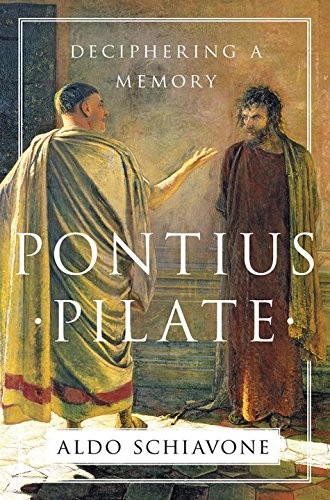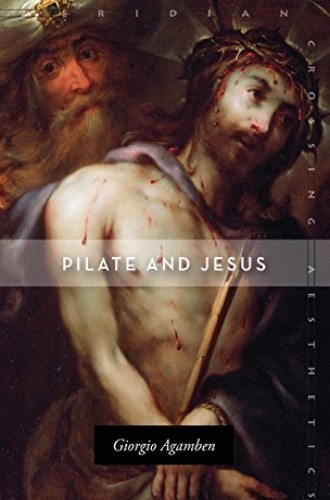Clash of cultures
Pontius Pilate shows us what happens when the historical and the eternal intersect.
How delightful it would be, I thought—and then I immediately chastened myself: delightful in a grave Lenten sort of way, of course—to prepare for Good Friday by reading two books about Pontius Pilate. These books resemble one another on the surface: each is written by an eminent Italian scholar, and each features a vivid cover portrait of Jesus and Pilate.
But I was wrong to think that they would be similar. One is a carefully-researched revisionist history that adjudicates fact from fiction as it reconstructs a plausible account of the overnight encounter between Jesus, Pilate, and the chief priests. The other is a kaleidoscopic journey across the history of interpretation of Pilate, aimed at illuminating the role of legal judgment in a society whose members are trying to work out the relationship between the historical and the eternal. Both are worth reading.
I began with Aldo Schiavone’s masterful biography of Pilate. Schiavone’s expertise in Roman law and rigorous scholarly method give credibility to his account of Pilate’s character, motivations, and emotions during the hours between Jesus’ arrest and crucifixion. Schiavone relies mostly on John’s narrative, although he also draws upon the synoptic accounts. He’s not shy about naming contradictions and prejudices, from Philo to Josephus to the gospel writers. For example, regarding Matthew’s story of Pilate’s handwashing and the crowd’s response (“His blood be on us and on our children!”), Schiavone writes:
Not a single word of this can be believed. Poorly concealed, there surfaces in it, quite distinctly, an overload of prejudice and ideology that takes us straight to what we might define as the zero point in the genealogy of Christian anti-Semitism—to the origins of a Western tragedy.
For Pilate to adopt a Jewish custom in “such a demeaningly odd manner” would have been unthinkable, nor did he immediately thereafter (as the gesture would indicate) abdicate his role in the unfolding story. Matthew, by expanding a small group of religious leaders into “the whole people” and placing responsibility among them, created the conditions for “a deep well of poison that would be transmitted, intact and baleful, down the centuries, preserved in the heart of a memory that became increasingly precious and untouchable.”
Schiavone highlights several conflicts between Roman law and Judaism that occurred across Pilate’s governorship, both before and after Jesus’ crucifixion. But at the heart of Schiavone’s account is a deeper clash that emerges in Jesus’ dialogue with Pilate:
The kingdoms—that of God and that of Caesar—are not on the same plane; there is no symmetry. . . . Each of us is always suspended between the two . . . and must choose: for humans, the autonomy of the two worlds on the plane of history is at once the guarantee of liberty and the condition of a continual laceration.
This laceration is precisely what animates Giorgio Agamben’s exploration of Pilate. Agamben is a philosopher and political theorist most famous for his multi-volume Homo Sacer theory (which I won’t pretend to understand beyond this very clear encapsulation). His book on Pilate is easier to read then his more philosophical writings—which I find impenetrable—but it still requires thinking on several levels at once.
In the person of Pilate, Agamben argues, history breaks into the economy of salvation. The incommensurability of these realms doesn’t diminish Pilate’s “passions and doubts, his caprices and scruples.” The coincidence of historical character and theological persona, of “juridical trial and eschatological crisis,” in the encounter between Jesus and Pilate reveals a deeper question: Who should judge and who should be judged?
Agamben doesn’t answer this question, but he compellingly sums up its tensions in language that’s as homiletical as it is enigmatic:
He—who has come not to judge the world but to save it—finds himself, perhaps precisely for this reason, having to respond in a trial, to submit to a judgment, which his alter ego, Pilate, in the end will not pronounce, cannot pronounce. Justice and salvation cannot be reconciled; every time, they return to mutually excluding and calling for each other. Judgment is implacable and at the same time impossible, because in it things appear as lost and unsavable; salvation is merciful and nevertheless ineffective, because in it things appear as unjudgable. . . . The world, in its fallenness, does not want salvation but justice. And it wants it precisely because it is not asking to be saved. As unsavable, creatures judge the eternal: this is the paradox that in the end, before Pilate, cuts Jesus short. Here is the cross; here is history.
Reading Agamben felt like riding all the rides in an amusement park in rapid succession—dizzying and thrilling. I could stomach it perhaps only because I’d first come to know Pilate through Schiavone’s clear, compelling exegesis.








